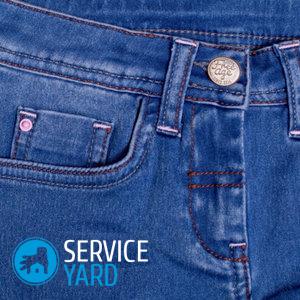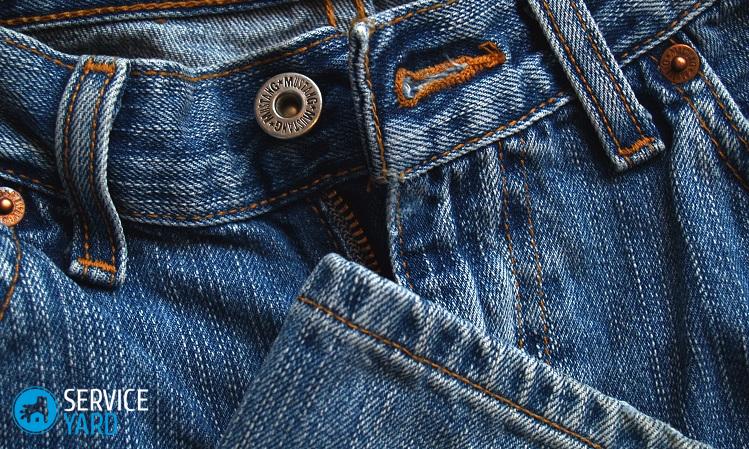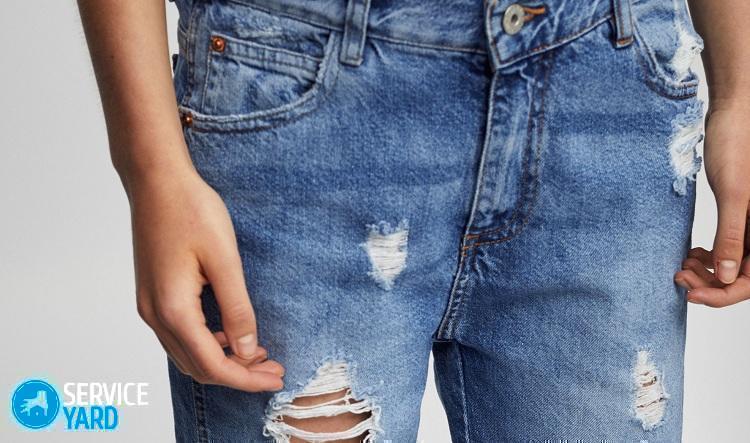How to put a button on jeans?

Most often, buttons on jeans are presented in the form of metal rivets, which do not come off as quickly as classic ones. However, if the rivet has come off, the process of fixing the fastener turns into a real problem. Today we will tell you how to put a button on jeans, because, you see, just sew it with a needle and thread will not work. What can be done in this situation so as not to buy new pants due to the wear of only the fastener?
to contents ↑Types of Denim Clasps
If the come off button is not lost, then take it to the store and buy the same. Denim fasteners can have the following sizes in diameter:
- 14 mm
- 17 mm.
- 19 mm.
- 20 mm.
- 22 mm.
- 25 mm
- 26 mm.
- 30 mm
- 40 mm.
Important! If the button is lost, measure the length and height of the buttonhole to approximately determine the diameter and height of the fastener.
Depending on the type, denim fasteners can be installed on a special stud (hairpin). Denim cloves can be of the following varieties:
- Smooth all-metal. The length of the standard part is 10-12 mm.
- Smooth tubular metal. The length of the tubular product is 8 mm.
- With a circular notch.
Important! To put a button on jeans with your own hands, carnations made of aluminum are most suitable. They are easy to process, but not inferior to steel in strength.
- On a stable leg without a central hole. As a rule, the metal shell of the button is filled with impact-resistant plastic. This clasp is mounted on a stud with a circular notch. Rivets on a steady core are the most durable in operation and the easiest to install.
- On a stable leg with a notch. Clasp manufacturers recommend installing them on smooth studs (all-metal or tubular). However, installing a button on jeans with all-metal studs is quite difficult, since accurate alignment must be observed. Therefore, it is better to use circular notched parts.
- On a broken leg without a hole. A button is installed on a denim stud with a smooth shaft or on a metal tubular carnation.
- On a broken rod with a hole. These types of rivets are mounted on an all-metal smooth or on a metal tubular nail for denim.
- On a double hairpin. A distinctive feature of the part is the solid bottom of the leg, which is pierced with a double nail. The antennae of the hairpin subsequently bend towards each other. The disadvantage of such fasteners is often breaks off one of the antennae mounting.
How to install a button on jeans?
Each type of fastener needs a different approach. However, there are a lot of similarities in repair methods.
Use the following guidelines when installing the fastener on the fabric:
- It is very difficult to make a button on jeans if it has a convex or concave shape of the top. With the inevitable blows of the hammer on such a part, its shape can change, and not for the better. We recommend not to buy such rivets at all or to install them in a special workshop.
- Choose immediately a kit consisting of a button and a denim stud.
- If the hairpin is longer than necessary, then it can be cut or bitten off using a side cutter or pliers.And you can put a gasket under it from the wrong side.
- Before attaching the button to the material, it is necessary to determine and mark its future location.
- Punches for studs make a punch, an awl, a thick needle so that the sharp ends of the studs do not tighten.
- All types of hairpins are inserted into the recess from the wrong side of the fabric, and the button itself is adjusted from the front.
- It is best to manually fasten a rivet without a central recess and on a stud with a circular notch.
How to insert a button into jeans - installation methods
Having a little understanding of the basic rules for doing this work and possible variations of the fasteners, consider how to repair a button on jeans, depending on its type.
Rivet on a stable shaft without a hole
It is easiest at home to put a flat button without a notch and on a hairpin with a circular notch.
Proceed as follows:
- Decide and mark the location of the clasp.
- At the installation site, pierce the fabric with a hand punch, an awl or a nail.
- Insert the nails into the hole on the wrong side of the fabric.
- Attach the button cap to the hairpin on the front side. The button will be installed evenly and correctly if the nails enter the hole in a strictly vertical line.
- Press the button head against a horizontal hard surface.
- Hit the stud with a hammer, hammering it into the clasp. The impact should be clearly directed, but not with all its might, so as not to damage the part.
Important! Buttons on a plastic base without a metal sheath require special attention during installation. When driving the studs, it is necessary to observe the exact alignment, otherwise the rivet can simply crack. Better not to get such parts, so as not to risk it.
Denim rivet (with hole) on a stable leg
These buttons are installed in the same way as the previous type, but with some additions:
- If the special clove has a circular notch, then hammer it in and the clasp will be attached to the fabric - just like a button without a central recess.
- If the studs are all-metal or hollow tubular, then they themselves will easily go into the hole on the support, just insert them there. If the carnation “enters” with difficulty into the hole, then push it with a hammer.
After installation, the tip of the stud must be flattened:
- Shorten the smooth cloves with pliers to the required length.
- From the wrong side, place a flat metal object, such as a hammer, under the button.
- On the front side of the part in the recess, insert a bolt suitable for the diameter (for example, 5 mm).
- Hammer several times with a hammer to flatten its tip.
- The hairpin will spread out and fix.

Denim buttons (no hole) on the broken leg
Put a button on jeans on a smooth wooden surface. Since it is difficult to maintain alignment when hammering a special clove with a hammer, you may additionally need:
- A tube with an internal diameter of 9-10 mm and a length of 0.3-0.4 cm. If there is a socket wrench (9 mm in diameter), then use it.
- A smooth-head bolt with a diameter of 9 mm and a length of 0.6 cm.
Install the rivet as follows:
- If you fasten the button on a metal tube, use a 10 mm diameter tube or socket wrench.
- Hammer the hairpin.
- Set button cap.
- Twitch and check the installed product.
Important! Consider the length of a standard stud depending on the thickness of the fabric at the location of the fastener. The thinner the fabric, the less should be its length. If necessary, shorten the carnations with pliers.
Denim buttons (with hole) on broken support
Buttons are mounted, usually on all-metal aluminum or on a metal tubular carnation. Work on a flat metal or wooden surface:
- Punch the fabric at the installation site with a punch, awl or thick needle.
- Insert a special hairpin.
- If it is long, then bite off the excess with pliers.
- File the top of the clove.
- Insert the rivet hat.
- Insert a suitable bolt into the hole on the front of the part.
- Hit the stud several times with a hammer to flatten the tip and thereby secure it in the recess.
Important! To make it easier for you to make a button on jeans, consider these tips:
- If the nail is smooth with a top in the form of a tube, then its upper part must first be “turned” with a dowel with a conical end (or something similar). After the top of the tube is pulled apart by the petals, hit the bolt inserted into the button hole to secure the pin.
- The installation process can be simplified by using a denim with a circular notch. In this case, the stud must be hammered in the same way as in the case with the button on a stable leg.
Buttons on a double hairpin
Manually installing this type of rivet is quite simple:
- With an awl, punch two holes on the back of the button.
- Pierce a cloth with a stud.
- Put a rivet hat on the denim nails.
- Bend the ends of the studs into the buttons with a narrow screwdriver.
How to fix a button on jeans?
Very often rivets on a broken rod break on jeans. Under increased load, such products simply jump off the rod. This is their fault. To replace the rivet, you must remove its remnants.
This can be done with a side cutter or pliers in one motion. But you already know how to put a button on a rivet on jeans. Here are just a few tips:
- If there is no damage to the fabric, then buy a new fastener, then insert the button leg into the recess, and attach a metal hat to it. Turn the jeans over and press the hat against a horizontal hard surface. Hammer the rod to secure it.
- If the fabric is damaged at the location of the rivet, first put on a patch of denim, completely cover the damaged area. Sew the patch manually or on a typewriter several times. After that, install the rivet on the leg.
to contents ↑Important! If you are not lucky with metal rivets, then pick up a regular button for jeans. However, be careful about the size of the fastener - the button must be precisely matched to the size of the loop. Otherwise, a small part will not keep the jeans fastened, and too large will cause daily discomfort.
Stock footage
A breakdown or loss of a jeans button is not a reason to part with your favorite thing, because now you know how to install a button on jeans at home. And if you have any problems, then remember that experts in the workshop can use this equipment in a quality and qualified manner, so if necessary, contact them for help!
- How to choose a vacuum cleaner taking into account the characteristics of the house and coatings?
- What to look for when choosing a water delivery
- How to quickly create comfort at home - tips for housewives
- How to choose the perfect TV - useful tips
- What to look for when choosing blinds
- What should be running shoes?
- What useful things can you buy in a hardware store
- Iphone 11 pro max review
- Than iPhone is better than Android smartphones




